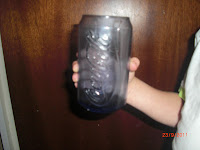Jump cut
http://en.wikipedia.org/wiki/Jump_cut
This is when two shots in a film are edited together so there is little change if any that is hard to notice, this helps change the camera position with the same image.
Over the shoulder shots
http://en.wikipedia.org/wiki/Over_the_shoulder_shot
This is when there is a shot and is usally shown from over the person shoulder as if it is their view. The shot usually includes the back of a persons head.
Cutaways
http://www.mediacollege.com/video/shots/cutaway.html
This is when there is a shot of action such as somebody drinking then it goes to a different shot such as the persons hand.
Point Of View Shots
http://en.wikipedia.org/wiki/Point_of_view_shot
This is when the camera shows what the character can see from there perspective this usually helps the viewer imagine they are involved.
Saturday, 24 September 2011
post 4: script writing
This is our groups script that we have annotated.On the script we have shown who thought of the ideas and how each member of the group contributted to the production of the script.
Types of contunuity problems would be, on the desk we plan to have work but if we have to do two differents days of filming the work may change postion.To over come this we plan to take a photo of the postion that the work is in. Also we may move the chairs to solve this we will but marks down where the chair legs are placed.
Tuesday, 20 September 2011
post 3: continuity
What is continuity?
Keeping the mis-en-scene the same throughout filming and having the characters stand in the same place as where there was a 'cut'.
The 180 degree rule and crossing the line
This is a rule that most movie makers stick to it allows the character to stay on the same side of the screen throughout filming.Such as if a character is on the left then that character will stay on the left.If the camera goes past the 180 degree shot it is crossing the line.
Shot reverse shot
This is when the camera switches its point of view, such as if two people were talking then one shot would be over one persons shoulder and the other shot will be other the next persons shoulder, they would be edited together.
What is match on action?
Match on action is where the production is cut from one shot to a different shot which usally makes a new view which matches the action from the first shot. Match on action gives an impression of continous time between the shots even if they were shot hours apart.
Monday, 19 September 2011
post 2: storyboard drawing,shot sizes and framing.
Shot Sizes
I have scanned in a copy of my notes that I have made,this is to show what each shot looks like.
I have scanned in a copy of my notes that I have made,this is to show what each shot looks like.
framing
 |
| This is an example of a extreme close up this is used to show facial expressions. |
 |
| This is an example of a close up this shows the facial expression and also some background. |
 |
| This is an example of a medium close up this shows the head and shoulders along with headroom. |
 |
| This is an example of a medium shot this shows more headroom and more body below the shoulders. |
 |
| This is an example of a 3/4 shot it shows more of the background and more of the body. |
 |
| This is an example of a medium long shot it shows more head room and also more body. |
 |
| This is an example of a long shot it shows headroom and also walking space.It also sets the scene as you see more of the mis-en-scene and you can use mis-en-scene to create the atmosphere |
 |
| This is an example of shot reverse shot which is usally used during speech. |
Rule of thirds
For the rule of thirds, imaginary lines are drawn dividing the image into thirds. The most important elements are placed where these lines intersect In addition to using the intersections, it also helps to use a 2 to 1 ratio so that nothing is dead center, which makes for a static image. Instead, when placing the horizon line of a landscape, or the eye line of a person, use the lower or upper third as an approximate guide.
 |
| This is my example of rule of thirds. |
Subscribe to:
Comments (Atom)















